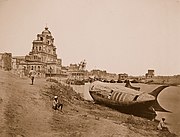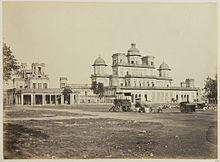Chattar Manzil
| Chattar Manzil | |
|---|---|
 Chattar Manzil in Lucknow | |
| Location | Lucknow, Uttar Pradesh, India |
| Coordinates | 26°51′31.29″N 80°55′56.62″E / 26.8586917°N 80.9323944°E |
| Architectural style(s) | Mughal architecture |
The Chattar Manzil (Urdu: چھتر منزل, Hindi: छतर मंज़िल), or Umbrella Palace is a building in Lucknow in Uttar Pradesh which served as a palace for the rulers of Awadh and their wives.[1]

Construction and architecture
[edit]
It was constructed by order of Nawab Ghazi Uddin Haider and completed after his death by his successor, Nawab Nasir Uddin Haider.[2][3][4]
The Chattar Manzil stand on the banks of the River Gomti. The Chattar Manzil consisted of a Bari (larger) Chattar Manzil and Chhoti (smaller) Chattar Manzil, however only the larger one still exists. These two buildings were examples of the Indo-European-Nawabi architectural style, even though the Bari Chattar Manzil has been altered over the years. The palaces were named after the chattris (umbrella-shaped domes) on the octagonal pavilions, which crown the buildings.[5] The imposing building has large underground rooms and a dome surmounted by a gilt umbrella.[1][2][3]
Usage
[edit]The Palace has gone through many owners including the Nawabs of Awadh Saadat Ali Khan and Wajid Ali Shah, and the British and changes since its construction was started in the 1780s.[6]
It served as a palace for the rulers of Awadh and their wives. Later during the Indian Rebellion of 1857 the building became a stronghold of the Indian revolutionaries.[4]
A portion of it was destroyed by British during the war of 1857.[7] After the war of 1857 the government had allotted the building to an American NGO which used it as a club for recreation purposes, till 1947, the Chhatar Manzil was used as the United Services Club.[2][4]
Post Independence, this building was allotted to the Council of Scientific and Industrial Research which used it as Central Drug Research Institute since 1950,[2][4] but now it has been vacated by CDRI.[3]
Government of Uttar Pradesh plans to set up two museums and a library at the Palace after its renovation and conservation by the State Archaeological Department.[6]
Popular culture
[edit]From the time of the Indian Rebellion of 1857 it was often photographed by such figures as Felice Beato, Samuel Bourne,[5] Darogha Ubbas Alli, and Thomas Rust.
In December 2013 a two-day Wajid Ali Shah Festival was organized by filmmaker Muzaffar Ali's Rumi Foundation at Chattar Manzil to pay tribute to the Nawab of Oudh.[8]
Hindi film Jolly LLB 2 was shot in Chattar Manzil.[9]
References
[edit]- ^ a b Misra, Amaresh (2004). Lucknow:Fire of Grace. ISBN 9788129104854.
- ^ a b c d "Chattar Manzil – Chattar Manzil Lucknow – Chattar Manzil in Lucknow India". Lucknow.org.uk. Retrieved 12 February 2014.
- ^ a b c "Save Our Heritage : Chattar Manzil, Lucknow". lucknow.me. 21 December 2013. Retrieved 15 April 2017.
- ^ a b c d "Chattar Manzil set to come alive". The Times of India. Times News Network. Archived from the original on 12 February 2014. Retrieved 12 February 2014.
- ^ a b "The Chattar Manzil Palace from the river, Lucknow". Bl.uk. 30 November 2003. Retrieved 12 February 2014.
- ^ a b "Chattar Manzil, then and now". The Hindu. 8 February 2014. Retrieved 12 February 2014.
- ^ "Save Our Heritage : Chattar Manzil, Lucknow | Save Our Heritage". Saveourheritage.in. 21 December 2013. Retrieved 12 February 2014.
- ^ Zia, Hassan (23 December 2013). "Nawab Wajid Ali Shah festival revamps essence of Chattar Manzil". TwoCircles.net. Retrieved 12 February 2014.
- ^ "Jolly LLB 2: Akshay Kumar lauds UP film policy". Hindustan Times. 17 August 2016. Retrieved 15 April 2017.
Further reading
[edit]- Shukla, J. D. (1976). History of Chattar Manzil. India: Central Drug Research Institute.
- Bayley, Stephan (12 March 2013). "All for the love of his wife!". The Lucknow Tribune. Lucknow. Archived from the original on 22 February 2014. Retrieved 12 February 2014.
External links
[edit]- NIC District Unit, Lucknow. Historical Places At Lucknow. Accessed 2 November 2006.
Text is available under the CC BY-SA 4.0 license; additional terms may apply.
Images, videos and audio are available under their respective licenses.

